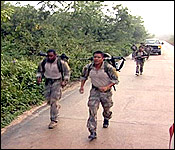
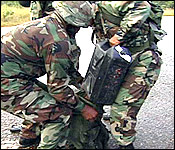
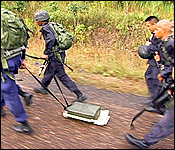
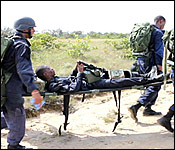 Last week Thursday and Friday we took you deep inside the Coast Guard's Best Warrior Competition. The events were punishing tests of physical and mental endurance that pitted the coast guard against other elite law enforcement units. But what we saw on Thursday and Friday was no match for the merciless obstacles of Saturday. 7News was out there all day getting our own workout and Daniel Ortiz reports:..
Last week Thursday and Friday we took you deep inside the Coast Guard's Best Warrior Competition. The events were punishing tests of physical and mental endurance that pitted the coast guard against other elite law enforcement units. But what we saw on Thursday and Friday was no match for the merciless obstacles of Saturday. 7News was out there all day getting our own workout and Daniel Ortiz reports:..
Daniel Ortiz reporting
When we arrived, the first 4 teams were already on the Hattieville Boom Road; we met up first with the favorites of the competition, the BSAG team. The squad was moving along, full gear in hand, weapons at the ready, and a 40 pound Bergan each to carry on their backs.
They were in Second place up until this point, and this was the event they were expected to dominate in. A little further up were the Seals, some members, walking some trotting, the first 2 days of exertion clearly having taken its toll.
About 15 minutes later, the Seals had to pick up their first extra burden, a jerry can filled with water - about 75 extra pounds of weight which they had to lug.
They chose to load it into a rucksack, a simple fix, but a huge burden for the bearer along the 8 mile March. It took 2 men to hoist it up unto the Seal member's back. Still up ahead, Recruit intake #5 was grinding along, 2 men balancing the Jerry can in the middle with a strap to support it.
One other comrade carried the bearer's rifle in relief, and there were also intervals where other team members took up the jerry can to give each bearer a rest.
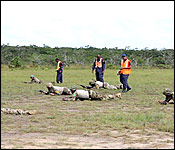
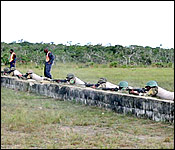
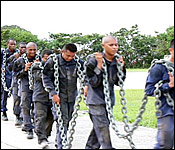 Up the road, the Officers team showed the most ingenuity. They found an old plastic cover for an AC vent, into which they placed the jerry can and dragged it along. It seemed the most efficient way to transport it on the road that day.
Up the road, the Officers team showed the most ingenuity. They found an old plastic cover for an AC vent, into which they placed the jerry can and dragged it along. It seemed the most efficient way to transport it on the road that day.
Lt. Monima, who had the most difficult of the 3 days, was leading his team way out in front, still showing strong. Back with the intake 5's squad, they had their ever faithful fellow recruits cheering them on, lending moral support, while some of the members struggled on the road.
The recruits were using ingenuity of their own. The burden bearers, were relieved of their weapons, which were all tied together and carried on a piece of stick between 2 members.
By that time, they had picked up yet another burden, a sack filled with sand, which this recruit hoisted on his shoulder. For the weapons, the recruits came up with yet a different strategy, tying about 4 or 5 weapons with a shirt and handing it to one team member to transport.
BSAG also carried the jerry can on a stick, and when we caught up with them again, the men were all walking, none were employing the brisk trot from earlier.
The Fleet team, the team leading the overall competition at this point, decided to allow one man to carry the jerry can on his back. But, the officials had yet another burden planned for them; they had to carry 2 cans of ammunition, to be used at the end of the challenge.
At different intervals when our camera caught up with them, the strain of the march was starting to tell on the 5 teams.
Coming close to the end of the march, the very exhausted squads then had to hoist one of their team members on a stretcher for a few hundred meters, all the way until the finishing line. The quickest team to the finish was Recruit Intake 5, with a time of 2 hours and 47 minutes, closely followed by BSAG reaching 5 minutes later.
Immediately after that 3 hours of non-stop marching, tired or not, they had to complete the final stage of the challenge.
Each team had to crawl 250 metres forward, to a firing point, and immediately try to shoot down 10 targets before 2 minutes was up. Depleted as they were, they were expected to engage and shoot with accuracy.
Of the 5 teams, BSAG Won hitting 9 out of 10 targets, besting the recruits who shot down 7 out of 10 to place second. After 3 hours of running - and two and a half days of being pushed to the edge physical limits, you might think that the team members were down for the count.
But, not these soldiers, they were still craving for more torment, jumping at the opportunity to take on the final obstacle course. They had to maneuver a tire-run, climb up onto a scaffolding type obstacle, low-crawl under barbed wires, get over 3 Parallel beams, scramble over a Retaining wall, swing through Monkey bars and get over a cargo net.
That first part then transitions to an open area where the competitors had to roll, run two laps while carrying a 250 pound log, run another lap with a 20-foot length of a thick, heavy chain, and finish off with a 18-20 foot Rope Climb.
The Fleet, which was ahead this morning, recovered from the march and shoot performance, and won the overall competition.
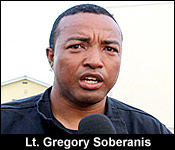 Lt. Gregory Soberanis - Commanding Officer, Fleet Squad
Lt. Gregory Soberanis - Commanding Officer, Fleet Squad
"As we conduct our physical training on a daily basis, we instill in them that sense of pride, integrity, intestinal fortitude, even though you are tired, even though you are fatigue, even though you are mentally and physically weak, you will dig deep and you push on and you accomplish the mission and task at hand."
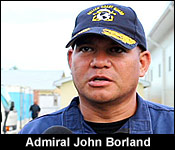 Admiral John Borland - Commandant, Belize Coast Guard
Admiral John Borland - Commandant, Belize Coast Guard
"What the competition did reveal to me though that if any elite unit does not maintain their standards in a strict regime and have parameters and rules and routines for them to test themselves routinely, even more than a monthly, weekly basis - they are going to lose their edge in the game and we saw that result here over the last couple of days. We saw a recruit squad that came very strong, but they are very young and they have to be develop physically for a couple more years. We saw a seal team that is not to its full strength because they have members training in the United States and they are down to the bare skeletal remains. They pushed hard, but I believe they could have pushed harder. We saw a fleet team, which is actually a team that is training now to become the first Coast Guard Infantry Marine Unit emerge and came out as the victors and they absolutely deserve it."
As noted in the interview, the fleet officers are training to become part of the first coast guard infantry marine unit.
| 
